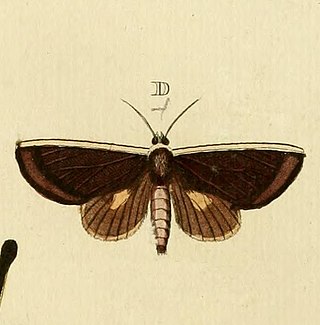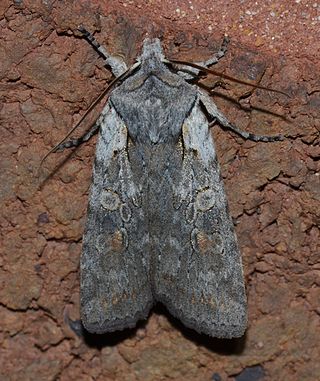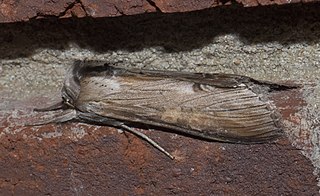
Gonodonta pyrgo is a species of fruit-piercing moth in the family Erebidae first described by Pieter Cramer in 1777. It is found in North America.
Nephelodes demaculata is a species of cutworm or dart moth in the family Noctuidae first described by William Barnes and James Halliday McDunnough in 1918. It is found in North America.

Condica begallo is a species of moth in the family Noctuidae. It was first described by William Barnes in 1905 and it is found in North America.
Gonodonta unica, the unica citrus moth, is a species of fruit-piercing moth in the family Erebidae. It is found in North America.
Plagiomimicus manti is a species of moth in the family Noctuidae. It was first described by William Barnes in 1904 and it is found in North America.

Hyppa contrasta, known generally as the summer hyppa moth or Russian mustard moth, is a species of cutworm or dart moth in the family Noctuidae. It is found in North America.
Euamiana dissimilis is a species of moth in the family Noctuidae. It was first described by William Barnes and James Halliday McDunnough in 1910 and it is found in North America.
Euamiana adusta is a species of moth in the family Noctuidae. It is found in North America.
Datana diffidens is a species of moth in the family Notodontidae. It was first described by Harrison Gray Dyar Jr. in 1917 and it is found in North America.
Properigea costa, the barrens moth, is a species of cutworm or dart moth in the family Noctuidae. It was first described by William Barnes and Foster Hendrickson Benjamin in 1923 and it is found in North America.

Azenia virida is a species of moth in the family Noctuidae. It was first described by William Barnes and James Halliday McDunnough in 1916 and it is found in North America.

Paectes pygmaea, the pygmy paectes, is a moth in the family Euteliidae. The species was first described by Jacob Hübner in 1818. It is found in North America.
Lineostriastiria olivalis is a species of moth in the family Noctuidae. It was first described by William Barnes and James Halliday McDunnough in 1916 and it is found in North America.
Homorthodes mania is a species of cutworm or dart moth in the family Noctuidae. It is found in North America.
Euxoa latro is a species of cutworm or dart moth in the family Noctuidae first described by William Barnes and Foster Hendrickson Benjamin in 1927. It is found in North America.

Lithophane antennata, known generally as the ashen pinion or green fruitworm, is a species of cutworm or dart moth in the family Noctuidae. It is found in North America.

Clostera strigosa, the striped chocolate-tip or drab tent-maker moth, is a species of moth in the family Notodontidae. It was first described by Augustus Radcliffe Grote in 1882 and it is found in North America.
Bleptina minimalis, the small owlet moth, is a species of litter moth in the family Erebidae. It was first described by William Barnes and James Halliday McDunnough in 1812 and it is found in North America.
Anarta alta is a species of cutworm or dart moth in the family Noctuidae first described by William Barnes and Foster Hendrickson Benjamin in 1924. It is found in North America.

Cucullia asteroides, known generally as the goldenrod hooded owlet or asteroid moth, is a species of moth in the family Noctuidae. It is found in North America.








